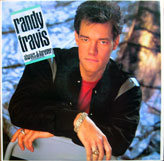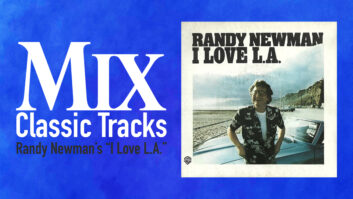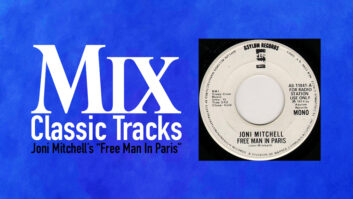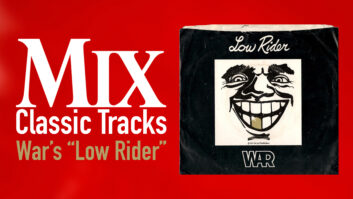
Before signing with Warner Bros. Records Nashville, Randy Travis spent a decade looking for a recording contract, and being rejected by everyone. In 1985, when engineer/producer Kyle Lehning first heard the artist then using the stage name “Randy Ray,” Travis was working as the catfish cook at the Nashville Palace; he would perform short sets when he could take a break from his shift in the kitchen.
“I was producing Keith Stegall for Epic at the time and he’s the one who brought Randy to my attention,” Lehning explains. “Keith was recording a live album with Randy at the time, and he wanted me to hear his voice. Randy made an impression because nobody was listening to hardcore country music at that time. It was the age of the lost years of the country crossover, where if records didn’t get played on Adult Contemporary radio, they didn’t sell. Kenny Rogers was having huge success, Anne Murray was doing well, and there were [other] people who were doing really well at the time with that sort of stuff, but none of them were hardcore country singers. Randy came from that real place. But the thing about his voice that got me wasn’t the genre. It was the honesty and the pure emotion that he naturally exuded. As far as I’m concerned, it doesn’t matter what kind of music you’re singing if you can sing like that. And that attracted me to him: an amazing voice and an amazing talent.”
Lehning became the producer of Travis’ first album, Storms of Life, which turned the artist into a sensation. He went from traveling in a bread truck with his band and gear to selling out multiple shows in the same city on the same days. By the time sessions began on the follow-up, Always & Forever, Travis was exhausted, although it didn’t affect his performance in the studio. Because he had such a clear sense of self and identity, he also had a keen ear when selecting material with Lehning. Additionally, time was on their side: the new wave of country music had not yet kicked in, which meant fewer artists were vying for the best available songs. The playing field was wide open for Lehning, Travis and his A&R person Martha Sharp to find and record some great material.
Released in April 1987, Always & Forever yielded four Number One singles, including “Forever and Ever, Amen,” Travis’ third Number One single. Written by Paul Overstreet and Don Schlitz, it’s a simple song with a simple message, but thanks to Travis’ pitch-perfect, unmistakable voice delivering the clever lyrics and easy melody, it was an immediate hit. Lehning remembers the session as “fun to record, but not difficult.”
“Forever and Ever, Amen” was recorded at Stargem in Nashville. Joe Bogan, who worked closely with Lehning on many projects, engineered the track, and Lehning produced. “Stargem was a fairly typical mid-’80s studio,” says Lehning. “They had an MCI 600 Series console, which was not always one of my favorites, but it sounded okay. There was nothing unique or special about the setup. Joe was a meticulous recording engineer and took maybe even a little more time than we were used to in Nashville, but I always gave him the time because the tracks that he recorded were done with such hi-fi and such nice taste that we saved a lot of time on the back end. Mixing them was sort of pulling the faders up and balancing more than it was having to go back in and do lots of EQ’ing and things like that. He did a lovely job on the front end.”

Producer Kyle Lehning
The tracking band was an A-list of Nashville session players: Jack Williams, bass; Dennis Burnside, piano; Russ Barenberg and Mark Casstevens, acoustic guitars; Steve Gibson, electric guitar; Doyle Grisham, steel guitar; Terry McMillan, harmonica; future Nashville producer and label president James Stroud, drums; Paul Overstreet, harmony vocals; and the Cherry Sisters (Sherry Huffman, Diane Tidwell and Lisa Silver) singing background vocals.
“Most of what you hear on the record is what came off the floor,” says Lehning. “Overdubs—I’d heard about Paul Franklin having this weird instrument called a Pedabro, which was a Dobro that had pedals on it like a steel guitar, that his dad had made. I thought, ‘What the heck; let’s give it a try.’ That’s the intro of the record, and Paul tells me it’s the first record that it was really used on and actually heard. Paul played here and there on the record, and Jerry Douglas also plays some Dobro fills. The intro and turnaround is Paul. Terry McMillan does this little harp backbeat, a little whoosh-through sound, that comes from when I was engineering Waylon Jennings’ records. His harmonica player, Donnie Brooks, did that on records and I always thought it was a cool sound.
“We went over the demo, they did the typical Nashville numbers charts, we went out in the studio, counted it off, and there wasn’t any resistance,” Lehning continues. ”Once we figured out the tempo, the key and the general feel for the record, everybody knew what to play. The demo was so great that the players had a natural sense of what to do. You pick the right players, you pick the right song, and then the producer’s job is to say absolutely as little as possible, and for the most part that was what I did.”
Travis cut his vocals later at Lehning’s studio, Morningstar, in nearby Hendersonville, where the record was also mixed. Because Travis was experiencing some road fatigue, says Lehning, “It probably took more passes than we were used to. It might have taken us two or three hours. We would wait until he’d come in and be in good voice, then it would be a couple or three passes, a punch-in here or there, and that was it.”
Lehning used an AKG C24, the same mic—literally the same one—he has used with Travis throughout their 25-year working relationship. “I’ve tried it on other people and it didn’t work at all,” he says. “I think it works for Randy because he has this incredibly rich kind of quality, and his low end could overwhelm other microphones. That one has a nice, open, airy quality to it and it allows his voice to come forward in the mix without getting boomy or having to roll a ton of bottom out. It was a nice balance. Randy’s not a loud singer. He has a nice, easy quality to his singing, so that microphone captured his voice really well, and still does.”
Both Storms of Life and Always & Forever were mixed through a Sound Workshop 1600 series console. “It had 26 inputs,” says Lehning, “and I had this other little 12×8 Sound Workshop sidecar mixer that I used for reverb, delays and things like that. We had an Otari MTR-90 and an Ampex ATR-102 half-inch machine, and I mixed off the Otari, no automation, so it was all me and my assistant, Kirt Odle. We’d mix until we made a mistake, stop the 2-track, roll the 24-track back, start the 2-track again and mix until we made a mistake. Then I’d cut the half-inch together to get the mix that we wanted. That’s the way we did all of it until we had automation. You’d pull out the 2-track of those mixes, and you’d better be ready to put splices together again!
“We had some nice outboard gear,” he continues. “I had a Fairchild compressor and four LA2A’s, a bunch of ADR outboard EQ—the E900s and Vocal Stressors—plus 1176s, dbx’s; it was a really well-equipped mid-’80s studio. We also had three EMTs with mono in and stereo out. My favorite that I used mostly on his vocal was an EMT 140 [plate reverb]. We had a Publison Infernal Machine and I would do that old ‘left pitch up, right pitch down’ thing: Anything that was panned to the right, I would add a little of it into the left return of the Publison, and anything that was panned to the left, I would add a little of that, so that there was a cross-pitch kind of thing to add a little mystery and depth, because we all thought that was cool back then!”
In 1987, “Forever and Ever, Amen” won the Grammy Award for songwriters Schlitz and Overstreet in the category of Best Country Song, and the track garnered two Academy of Country Music awards for Song of the Year and Single of the Year. Lehning believes that the success of this song resulted from a perfect storm of timing and artistry. “When we finished Storms of Life, I knew how much we’d spent on the record, and I had figured out that if we sold 40,000 albums, Warner Bros. would make their money back and then some, and let us make another one, which is all I was hoping for. And it sold about 4 million. ‘Forever and Ever, Amen’ sold north of 5 million. It was just the right guy, right time, right songs, and everybody was incredibly fortunate to have been there and caught that wave.”







